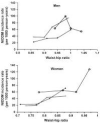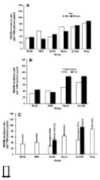Predictors of progression from impaired glucose tolerance to NIDDM: an analysis of six prospective studies
- PMID: 9075814
- PMCID: PMC2517225
- DOI: 10.2337/diab.46.4.701
Predictors of progression from impaired glucose tolerance to NIDDM: an analysis of six prospective studies
Abstract
Risk factors associated with the progression from impaired glucose tolerance (IGT) to NIDDM were examined in data from six prospective studies. IGT and NIDDM were defined in all studies by World Health Organization (WHO) criteria, and baseline risk factors were measured at the time of first recognition of IGT. The studies varied in size from 177 to 693 participants with IGT, and included men and women followed from 2 to 27 years after the recognition of IGT. Across the six studies, the incidence rate of NIDDM was 57.2/1,000 person-years and ranged from 35.8/1,000 to 87.3/1,000 person-years. Although baseline measures of fasting and 2-h postchallenge glucose levels were both positively associated with NIDDM incidence, incidence rates were sharply higher for those in the top quartile of fasting plasma glucose levels, but increased linearly with increasing 2-h postchallenge glucose quartiles. Incidence rates were higher among the Hispanic, Mexican-American, Pima, and Nauruan populations than among Caucasians. The effect of baseline age on NIDDM incidence rates differed among the studies; the rates did not increase or rose only slightly with increasing baseline age in three of the studies and formed an inverted U in three studies. In all studies, estimates of obesity (including BMI, waist-to-hip ratio, and waist circumference) were positively associated with NIDDM incidence. BMI was associated with NIDDM incidence independently of fasting and 2-h post challenge glucose levels in the combined analysis of all six studies and in three cohorts separately, but not in the three studies with the highest NIDDM incidence rates. Sex and family history of diabetes were generally not related to NIDDM progression. This analysis indicates that persons with IGT are at high risk and that further refinement of risk can be made by other simple measurements. The ability to identify persons at high risk of NIDDM should facilitate clinical trials in diabetes prevention.
Figures



Similar articles
-
Transient impaired glucose tolerance in South African Indians does not carry a risk for progression to NIDDM.Diabetes Care. 1997 Jul;20(7):1101-7. doi: 10.2337/diacare.20.7.1101. Diabetes Care. 1997. PMID: 9203444
-
Effects of diet and exercise in preventing NIDDM in people with impaired glucose tolerance. The Da Qing IGT and Diabetes Study.Diabetes Care. 1997 Apr;20(4):537-44. doi: 10.2337/diacare.20.4.537. Diabetes Care. 1997. PMID: 9096977 Clinical Trial.
-
[Steps toward the primary prevention of type II diabetes mellitus. Various epidemiological considerations].Invest Clin. 1997 Mar;38(1):39-52. Invest Clin. 1997. PMID: 9235072 Review. Spanish.
-
Abdominal obesity and physical inactivity as risk factors for NIDDM and impaired glucose tolerance in Indian, Creole, and Chinese Mauritians.Diabetes Care. 1991 Apr;14(4):271-82. doi: 10.2337/diacare.14.4.271. Diabetes Care. 1991. PMID: 2060430
-
Determinants for the progression from impaired glucose tolerance to non-insulin-dependent diabetes mellitus.Eur J Clin Invest. 1998 Sep;28 Suppl 2:8-13. doi: 10.1046/j.1365-2362.1998.0280s2008.x. Eur J Clin Invest. 1998. PMID: 9777321 Review.
Cited by
-
Changes in Weight and Glucose Can Protect Against Progression in Early Diabetes Independent of Improvements in β-Cell Function.J Clin Endocrinol Metab. 2016 Nov;101(11):4076-4084. doi: 10.1210/jc.2016-2056. Epub 2016 Aug 17. J Clin Endocrinol Metab. 2016. PMID: 27533307 Free PMC article. Clinical Trial.
-
Diabetes in ageing: pathways for developing the evidence base for clinical guidance.Lancet Diabetes Endocrinol. 2020 Oct;8(10):855-867. doi: 10.1016/S2213-8587(20)30230-8. Lancet Diabetes Endocrinol. 2020. PMID: 32946822 Free PMC article. Review.
-
Diabetes and cardiovascular disease: changing the focus from glycemic control to improving long-term survival.Am J Cardiol. 2012 Nov 6;110(9 Suppl):58B-68B. doi: 10.1016/j.amjcard.2012.08.036. Am J Cardiol. 2012. PMID: 23062569 Free PMC article. Review.
-
Risk of proteinuria among individuals with persistent borderline diabetes: the Saku study.Diabetol Int. 2015 Sep 4;7(2):181-187. doi: 10.1007/s13340-015-0235-x. eCollection 2016 Jun. Diabetol Int. 2015. PMID: 30603262 Free PMC article.
-
The association between sleep duration, sleep quality, and food consumption in adolescents: A cross-sectional study using the Korea Youth Risk Behavior Web-based Survey.BMJ Open. 2018 Jul 24;8(7):e022848. doi: 10.1136/bmjopen-2018-022848. BMJ Open. 2018. PMID: 30042149 Free PMC article.
References
-
- Harris MI, Hadden WC, Knowler WC, Bennett PH. Prevalence of diabetes and impaired glucose tolerance and plasma glucose levels in U.S. population aged 20-74 yr. Diabetes. 1987;36:523–534. - PubMed
-
- Geiss LS, Herman WH, Goldschmid MG, DeStefano F, Eberhardt MS, Ford ES, German RR, Newman JM, Olson DR, Sepe SJ, Stevenson JM, Vinicor F, Wetterhall SF, Will JC. Surveillance for diabetes mellitus: United States, 1980-1989. Morb Mortal Wkly Rep. 1993;42:1–20. - PubMed
-
- Tuomilehto J, Knowler WC, Zimmet P. Primary prevention of non-insulin-dependent diabetes mellitus. Diabetes/Metab Rev. 1992;8:339–353. - PubMed
-
- Knowler WC, Narayan KMV, Hanson RL, Nelson RG, Bennett PH, Tuomilehto J, Schersten B, Pettitt DJ. Preventing non-insulin-dependent diabetes. Diabetes. 1995;44:483–488. - PubMed
Publication types
MeSH terms
Grants and funding
LinkOut - more resources
Full Text Sources
Medical

